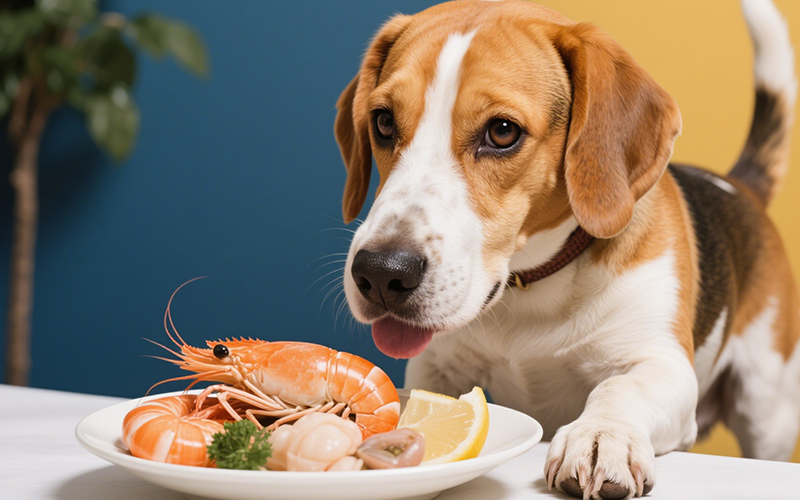Can Dogs Eat Seafood? Here's What You Need to Know
- 9 Apr 2025 14:39
Seafood is a popular treat for humans, but can it be a safe and healthy choice for your dog? While some types of seafood can be beneficial for your dog’s diet, there are several factors to consider before feeding them seafood. Let’s dive into the details!

Can Dogs Eat Seafood? 🤔
Yes, dogs can eat seafood, but not all seafood is created equal. Some types are safer and healthier for your dog than others. Seafood such as salmon, shrimp, and whitefish can be a good source of protein and omega-3 fatty acids when served in moderation. However, certain types of seafood and preparation methods can pose risks to your dog’s health.
The Benefits of Seafood for Dogs 🦞💥
High-Quality Protein 🍗
Seafood is rich in high-quality protein, which is essential for your dog’s muscle growth, energy, and overall health. Protein is a key building block for maintaining strong muscles and healthy tissues.Omega-3 Fatty Acids 🧡
Fish like salmon and sardines are packed with omega-3 fatty acids, which support heart health, joint health, and contribute to a shiny coat and healthy skin. These fatty acids also have anti-inflammatory properties, which can be beneficial for dogs with conditions like arthritis.Vitamins and Minerals 💊
Seafood contains essential vitamins and minerals, including vitamin B12, iron, and selenium, which contribute to a healthy immune system and overall well-being. These nutrients help support your dog’s energy levels, digestion, and brain function.Low in Fat 🐕
Certain seafood options like whitefish are lower in fat compared to other animal proteins. This makes them a good choice for dogs who need to manage their weight.
The Risks of Seafood for Dogs 🚨
While seafood can be a healthy treat, there are several risks and precautions to take when feeding it to your dog:
Mercury and Toxins ⚠️
Some types of seafood, especially larger fish like tuna and swordfish, can contain high levels of mercury and other environmental toxins. These can accumulate in your dog’s system over time, leading to potential health problems like kidney damage or neurological issues. Stick to smaller fish such as sardines, salmon, and herring, which have lower mercury levels.Shellfish Hazards 🦀
While shrimp and lobster are generally safe for dogs, there are some important considerations:Shellfish like clams, mussels, and oysters can cause allergic reactions in some dogs.
Raw shellfish should be avoided, as it may contain bacteria, viruses, or parasites that could harm your dog.
Be sure to remove the shells to prevent choking hazards and digestive blockages.
Bones in Fish 🦴
Fish like salmon or sardines may contain small bones that can be a choking hazard or cause internal injury. Remove the bones before feeding your dog fish to avoid these risks.Added Ingredients 🍳
Many seafood dishes for humans are prepared with butter, garlic, onions, or spices, all of which can be harmful or toxic to dogs. Always serve seafood plain—no added salt, seasoning, or butter. If you’re giving your dog seafood, stick to unseasoned, cooked seafood.Allergies 🐶
Some dogs may have an allergic reaction to seafood. Watch for signs like itchy skin, vomiting, or diarrhea after feeding them seafood for the first time.
How to Safely Serve Seafood to Your Dog 🍽️
If you decide to give your dog seafood, there are a few tips to follow to make sure it’s safe and beneficial:
Cook the Seafood Thoroughly 🍳
Always cook seafood thoroughly before giving it to your dog. Cooking kills harmful bacteria, parasites, and viruses that can be present in raw seafood. Avoid serving raw fish or shellfish to prevent contamination.Remove the Shells 🦐
If you’re feeding your dog shrimp, lobster, or other shellfish, make sure to remove the shells to prevent choking and ensure easier digestion.No Seasoning 🧂
Avoid adding seasoning, salt, or other ingredients to the seafood. Dogs have different dietary needs, and many seasonings, especially garlic and onions, are toxic to them.Serve in Moderation ⚖️
Seafood can be a healthy addition to your dog’s diet, but it should be fed in moderation. Too much seafood, especially fish, can lead to nutritional imbalances or contribute to weight gain.Choose Safer Seafood Options 🌊
Some safer seafood choices for dogs include:Salmon (cooked)
Sardines (in water, no added salt)
Whitefish (like cod or haddock)
Shrimp (peeled and cooked)
Pollock (a type of whitefish)
Safe Seafood Alternatives 🐟
If you’re looking for other protein options for your dog, consider these alternatives:
Chicken 🍗
Lean chicken is a great source of protein and can be served cooked without any added seasoning or bones.Turkey 🦃
Lean turkey is another excellent option for dogs, rich in protein and nutrients.Beef 🥩
Lean beef is another safe meat that provides essential nutrients for dogs, especially when served in moderation.Lamb 🐑
Lamb is an alternative for dogs who may have allergies to more common proteins like chicken or beef.
How PettureX Can Help 🧠
If you’re ever uncertain about whether seafood is right for your dog or if you need help understanding what foods are safe and beneficial, PettureX is here to assist! With 24/7 consultations and pet image recognition, PettureX can guide you in making the best choices for your dog’s health.
Conclusion: Can Dogs Eat Seafood? ✅
Yes, dogs can eat seafood, but there are important considerations. Cook seafood thoroughly, avoid raw shellfish, remove bones and shells, and serve in moderation. Safe options include salmon, sardines, whitefish, and shrimp (without seasoning).
For any concerns about your dog’s diet or health, PettureX is always available to provide guidance and support.
Need help with your dog’s health or diet? Try PettureX for expert advice anytime! 🐶💚
Related

Can Dogs Eat Peaches? Vet Explains Benefits, Cyanide Risks & Safe Serving
- 16 Apr 2025
Can Dogs Eat Mulberries? Vet Explains Safety, Benefits & Potential Risks
- 16 Apr 2025
Can Dogs Eat Mozzarella? Vet Explains the Cheesy Truth (Risks & Benefits)
- 16 Apr 2025
Can Dogs Eat Maple Syrup? The Sugary Truth & Why Vets Advise Against It
- 16 Apr 2025
Can Dogs Eat Mango Skin? Vet Explains Why It's a Risky Chew!
- 16 Apr 2025
Can Dogs Eat Mac n Cheese? Vet Explains Why This Comfort Food Is Unsafe!
- 16 Apr 2025
Can Dogs Eat Liver? Vet Guide to This Nutrient-Dense Organ Meat (Benefits & Risks!)
- 16 Apr 2025
Can Dogs Eat Lamb? Vet Insights on This Nutritious Meat Option
- 16 Apr 2025
Can Dogs Eat Licorice? The Sweet Danger & Glycyrrhizin Risk Explained by Vets
- 16 Apr 2025
Can Dogs Eat Jelly? The Sweet Truth About Sugar, Xylitol & Why Vets Say No!
- 16 Apr 2025
